Overview
The article presents ten smart grid cybersecurity plans that energy companies can implement to bolster their defenses against cyber threats. It highlights the critical need for comprehensive strategies, including:
- Regular vulnerability assessments
- Robust access controls
- Employee training
These measures are essential for safeguarding critical infrastructure and ensuring operational integrity in an increasingly complex cyber landscape. Energy companies must recognize the importance of these strategies to effectively navigate the evolving challenges posed by cyber threats.
Introduction
The increasing reliance on smart grid technology in the energy sector has ushered in unprecedented efficiency and connectivity. However, this advancement has simultaneously unveiled critical vulnerabilities to cyber threats. This article delves into ten essential cybersecurity plans that energy companies can implement to fortify their operations against these evolving risks. As the stakes escalate, organizations must effectively balance innovation with the imperative of safeguarding their infrastructure from potential attacks. The following strategies not only address immediate security concerns but also lay the groundwork for a more resilient future in energy management.
Harbinger Land: Advanced Title Research Solutions for Secure Land Acquisition
Harbinger Land addresses a critical challenge in the land acquisition process: ensuring compliance with complex legal and regulatory requirements. Leveraging AI-powered title research software alongside efficient document imaging solutions, Harbinger Land optimizes this intricate process. By digitizing property data and deploying imaging agents to courthouses, or acquiring documents through records requests, title agents can complete their research and leasing tasks in a manner that is both efficient and cost-effective.
This groundbreaking technology significantly accelerates acquisitions while minimizing the risk of conflicts and fraud—essential elements in safeguarding project integrity. By securing clear and reliable land titles, power firms can focus on their core operations, free from the potential legal challenges that often accompany land transactions.
The integration of such technology not only enhances operational efficiency but also fosters a more transparent and trustworthy acquisition environment, ultimately supporting the successful implementation of energy initiatives. For instance, Vanguard's Land Acquisition Specialist underscores that advancements in GIS technology have revolutionized land acquisition by streamlining site selection and ensuring compliance with zoning regulations.
In conclusion, embracing these technological advancements is imperative for firms aiming to navigate the complexities of land acquisition effectively and securely.
Identify Vulnerabilities in Smart Grid Infrastructure
Energy firms must prioritize thorough evaluations as outlined in their smart grid cybersecurity plans to uncover vulnerabilities within their smart grid infrastructure. This necessitates a meticulous assessment of hardware, software, and communication protocols as part of smart grid cybersecurity plans to pinpoint potential weaknesses that cyber attackers could exploit. Frequent vulnerability evaluations are essential for sustaining a proactive strategy in smart grid cybersecurity plans against emerging risks, ensuring that security measures remain current and effective. As we approach 2025, the landscape of smart grid vulnerabilities has evolved, with recent cyber threats underscoring the imperative for power providers to implement smart grid cybersecurity plans and adopt best practices in vulnerability evaluation. By employing systematic evaluation methods, organizations can enhance their defenses and bolster overall resilience against cyber risks.
At the Cyber Risk Virtual Summit 2025, which convened nearly 4,500 leaders, the collaboration between Chief Information Security Officers (CISOs) and General Counsels (GCs) emerged as crucial for effectively addressing these vulnerabilities. Craig Rogers from Eversheds Sutherland remarked, "If the GC and CISO always agree, something is wrong. You need a bit of tension — it means you’re working through the issues before they become a crisis." This statement highlights the importance of integrating cybersecurity into governance frameworks, ensuring that vulnerability evaluations are not only thorough but also aligned with the strategic objectives of utility firms.
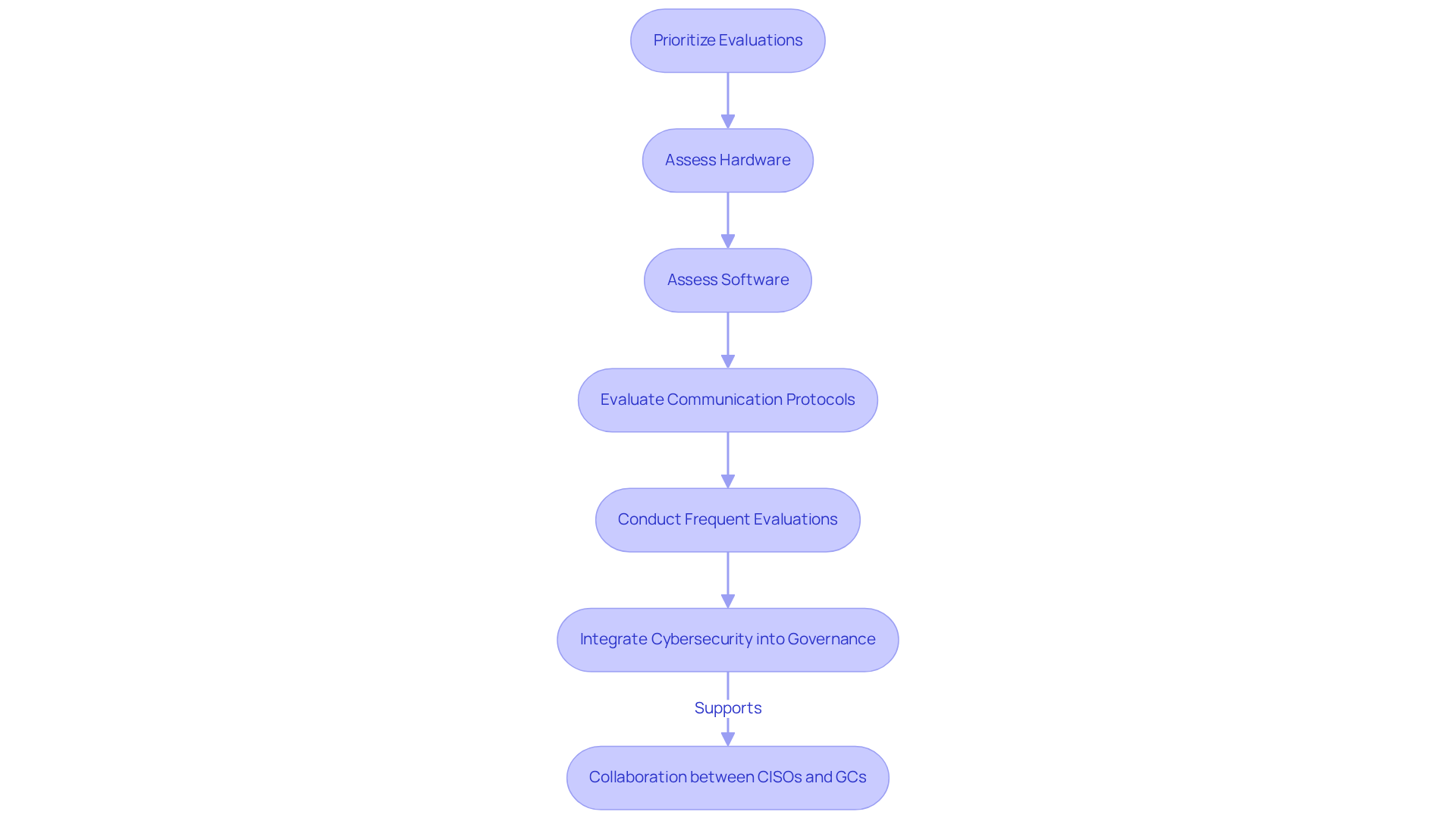
Implement Robust Access Controls and Authentication
Implementing robust access controls and authentication mechanisms is vital for safeguarding smart grid systems. Multi-factor authentication (MFA) serves as a critical layer of protection, ensuring that only authorized personnel can access sensitive data and systems. This method significantly mitigates the risk of unauthorized access by requiring multiple forms of verification beyond a mere username and password. Furthermore, MFA can provide a competitive advantage in the energy industry by enhancing customer confidence in protective measures.
Role-based access controls (RBAC) further bolster security by restricting access according to user roles and responsibilities. This strategy not only diminishes the potential for insider threats but also streamlines the administration of user permissions, allowing organizations to tailor access levels based on specific job functions. For example, in a case study involving DTEK, the implementation of Azure Active Directory MFA and passwordless login solutions enabled approximately 2,000 business users to securely access systems while upholding stringent access controls for privileged accounts. This initiative resulted in improved protective measures and a better user experience, underscoring the effectiveness of these technologies.
Best practices for access controls in smart grid systems include:
- Regularly reviewing user permissions
- Adhering to the principle of least privilege
- Conducting thorough audits to identify and rectify potential vulnerabilities
Additionally, organizations must remain vigilant regarding the risks associated with physical tokens and soft tokens, as these can pose threats if not managed correctly. By adopting these strategies, energy firms can significantly enhance their defenses against cyber threats through effective smart grid cybersecurity plans, ensuring the integrity and reliability of their infrastructure.
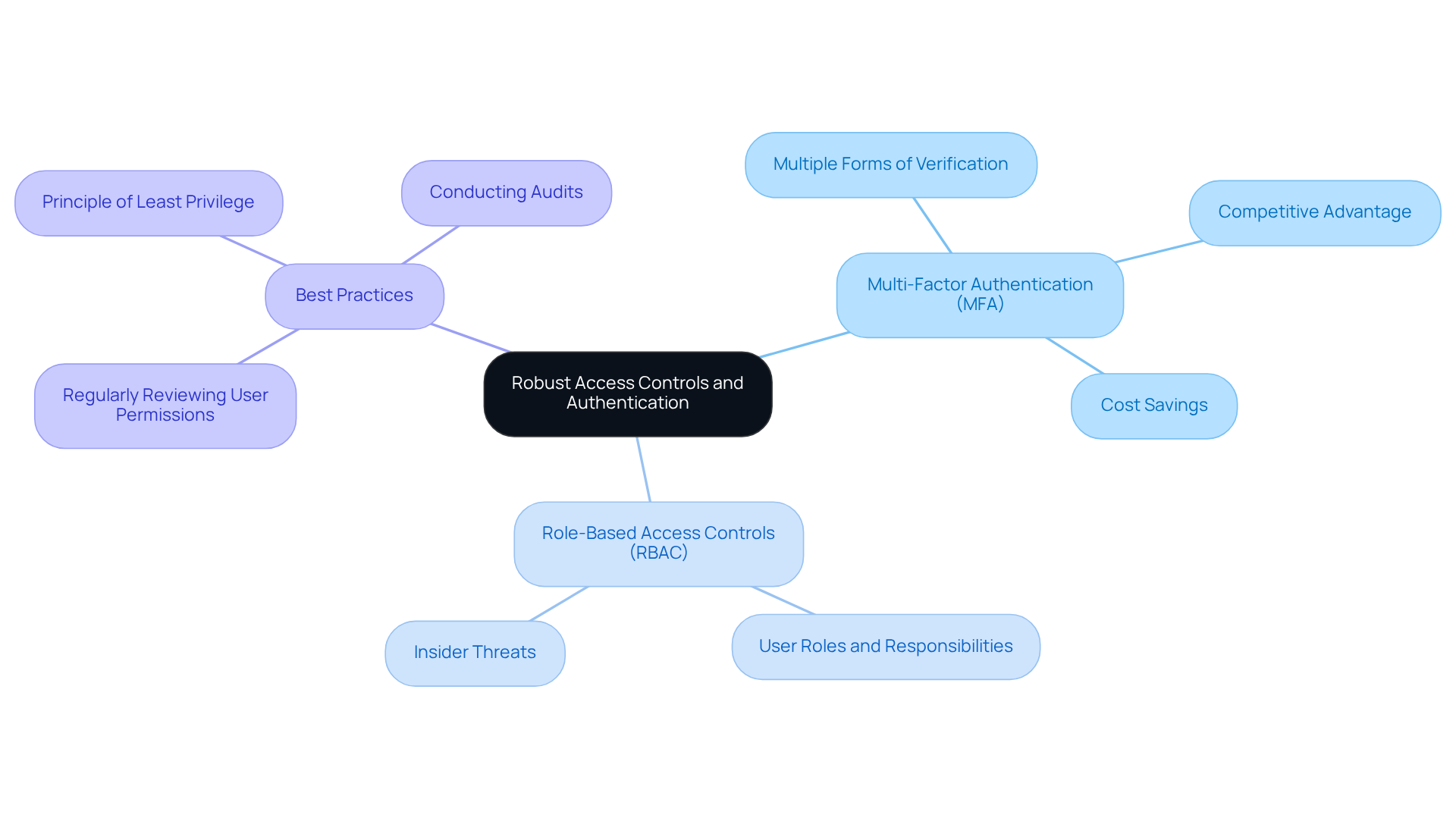
Conduct Regular Vulnerability Assessments and Penetration Testing
Regular vulnerability assessments and penetration testing are imperative for identifying security gaps in smart grid systems, which are essential components of smart grid cybersecurity plans. These proactive measures allow organizations to simulate attacks and evaluate their defenses, ensuring that vulnerabilities are addressed before they can be exploited by malicious actors. By establishing a routine schedule for these assessments, organizations can significantly enhance their overall cybersecurity posture.
Consider the potential risks of neglecting these assessments. Without regular testing, security gaps can remain undetected, leaving systems vulnerable to exploitation. This highlights the necessity of implementing a structured approach to cybersecurity.
The benefits of conducting these assessments extend beyond mere compliance; they foster a culture of security awareness within the organization. By actively engaging in vulnerability testing, organizations not only protect their assets but also instill confidence among stakeholders.
In conclusion, prioritizing regular vulnerability assessments is a critical step toward safeguarding smart grid systems as part of smart grid cybersecurity plans. Organizations must take action now to bolster their defenses and mitigate risks effectively.
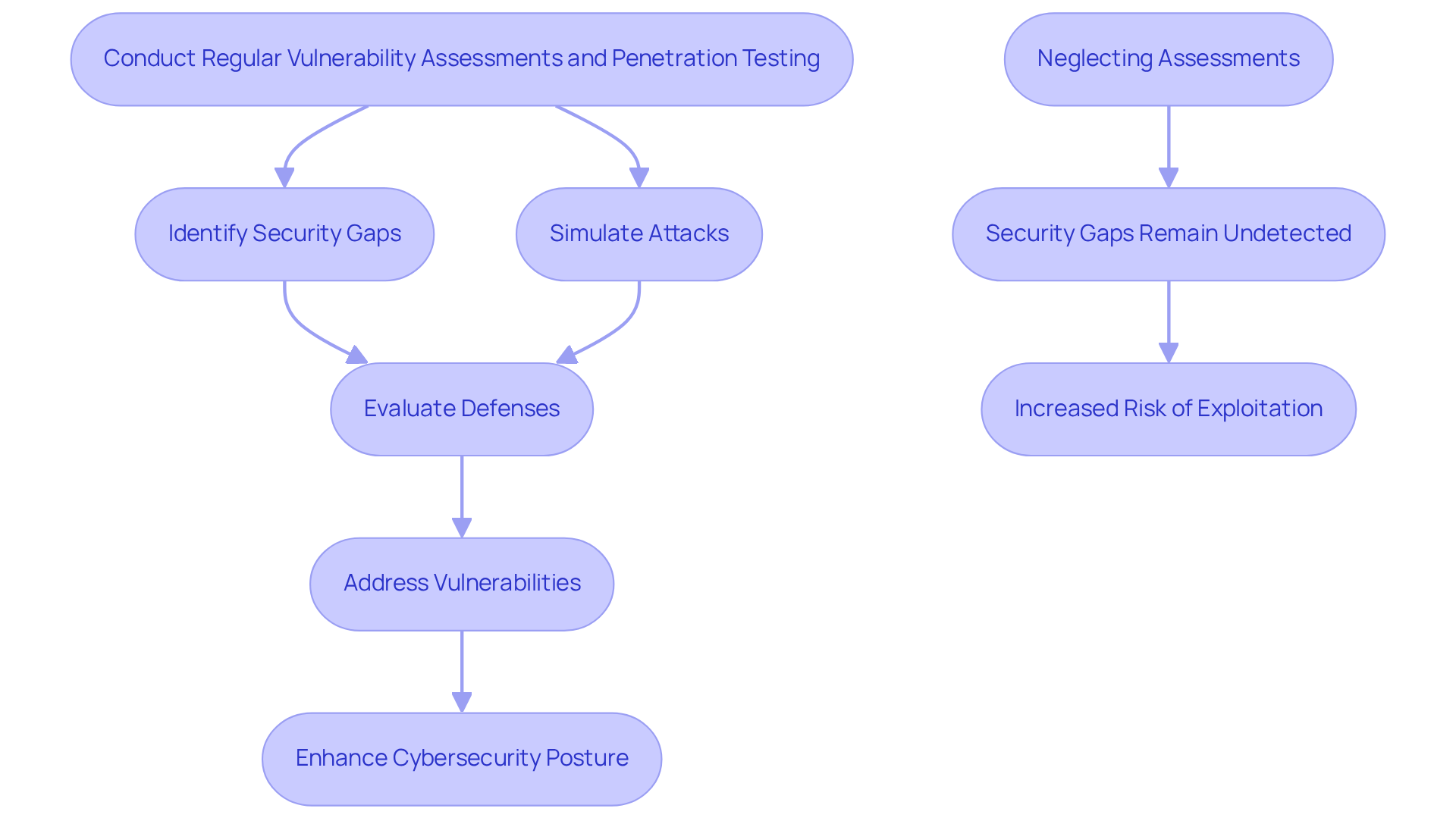
Develop an Incident Response Plan for Cyber Attacks
A robust incident response strategy is essential for utilities to adeptly navigate the complexities of cyber attacks while ensuring the effectiveness of their smart grid cybersecurity plans. This strategy must outline explicit procedures for detecting, responding to, and recovering from incidents within the framework of smart grid cybersecurity plans. Key components include:
- Establishing a Response Team: Designate a skilled team responsible for managing incidents, ensuring they are well-trained and equipped to handle various scenarios.
- Defining Communication Protocols: Create clear lines of communication both internally and externally to facilitate timely information sharing during an incident.
- Conducting Regular Drills: Implement routine drills to test the effectiveness of the response plan, ensuring that all team members understand their roles and can act swiftly under pressure.
Research reveals that only 38% of organizations with over 500 employees possess an incident response plan, underscoring a substantial gap in preparedness. Companies that implement smart grid cybersecurity plans are less inclined to depend solely on insurance for incident management, highlighting the significance of proactive measures. Moreover, organizations that contain a breach in under 30 days can save over $1 million compared to those with extended response times. By prioritizing strategies like regular testing and employee training, energy firms can markedly diminish the impact of cyber attacks on their operations.
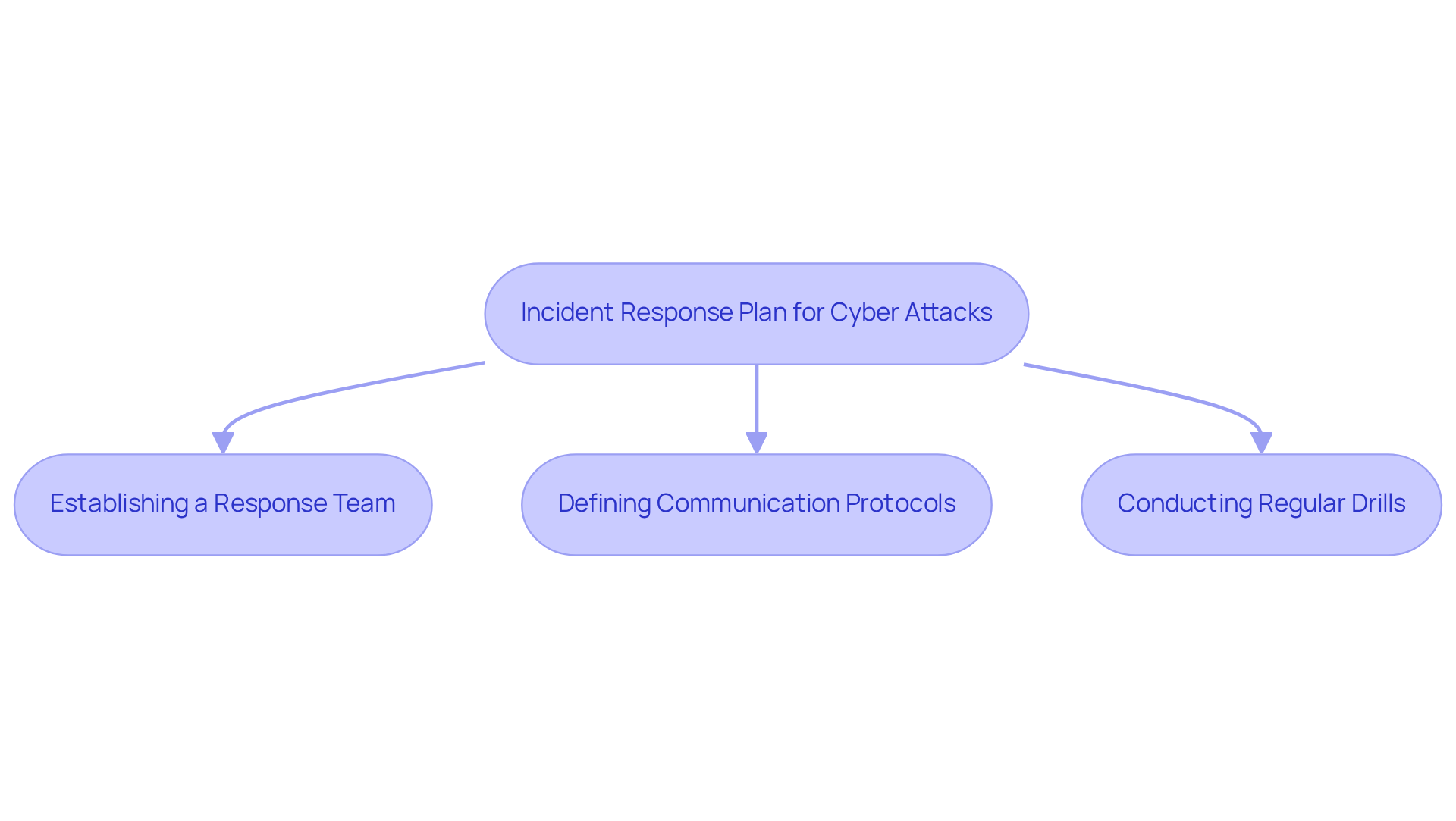
Ensure Security of IoT Devices and Sensors
Securing IoT devices and sensors is paramount for the protection of smart grid infrastructure as outlined in smart grid cybersecurity plans. To effectively safeguard these devices from potential threats, companies must incorporate smart grid cybersecurity plans that include:
- Robust encryption protocols
- Regular firmware updates
- Secure network configurations
Monitoring IoT devices for unusual activity is also essential to inform smart grid cybersecurity plans, as it enables early detection and mitigation of attacks before they escalate.
Consider this: recent information from the 2024 Data Breach Investigations Report reveals that over 70% of manufacturers have reported cyber incidents associated with IoT devices. This statistic underscores the necessity of adopting these protective measures.
Moreover, case studies demonstrate that organizations utilizing established IoT protection frameworks, such as the NIST IoT Cybersecurity Framework, can decrease cyberattack risks by up to 60%. This emphasizes the effectiveness of proactive strategies.
As the power industry encounters rising challenges from hacktivists and nation-state actors, particularly those linked to geopolitical tensions, prioritizing smart grid cybersecurity plans transcends being merely a best practice; it is an essential requirement for upholding operational integrity and resilience.

Establish Monitoring and Threat Intelligence Systems
Establishing strong monitoring and risk intelligence systems is essential for energy firms to efficiently identify and respond to cyber threats in real-time. Continuous monitoring of network traffic, alongside user behavior analytics, enables organizations to swiftly detect anomalies and potential breaches. By integrating these systems with security intelligence feeds, businesses can remain informed about emerging threats, thereby enhancing their situational awareness.
For example, organizations that have adopted advanced monitoring solutions report significant improvements in incident response times, with some achieving reductions of up to 50% in detection and response durations. Additionally, recent advancements in cybersecurity monitoring for smart grids emphasize the critical need for smart grid cybersecurity plans, as they provide vital insights into potential vulnerabilities and attack vectors.
Experts emphasize that a proactive approach to intelligence integration not only fortifies defenses but also cultivates a culture of security awareness within the organization. By prioritizing these systems, firms in the power sector can substantially bolster their cybersecurity posture and safeguard their essential infrastructure against evolving cyber threats.
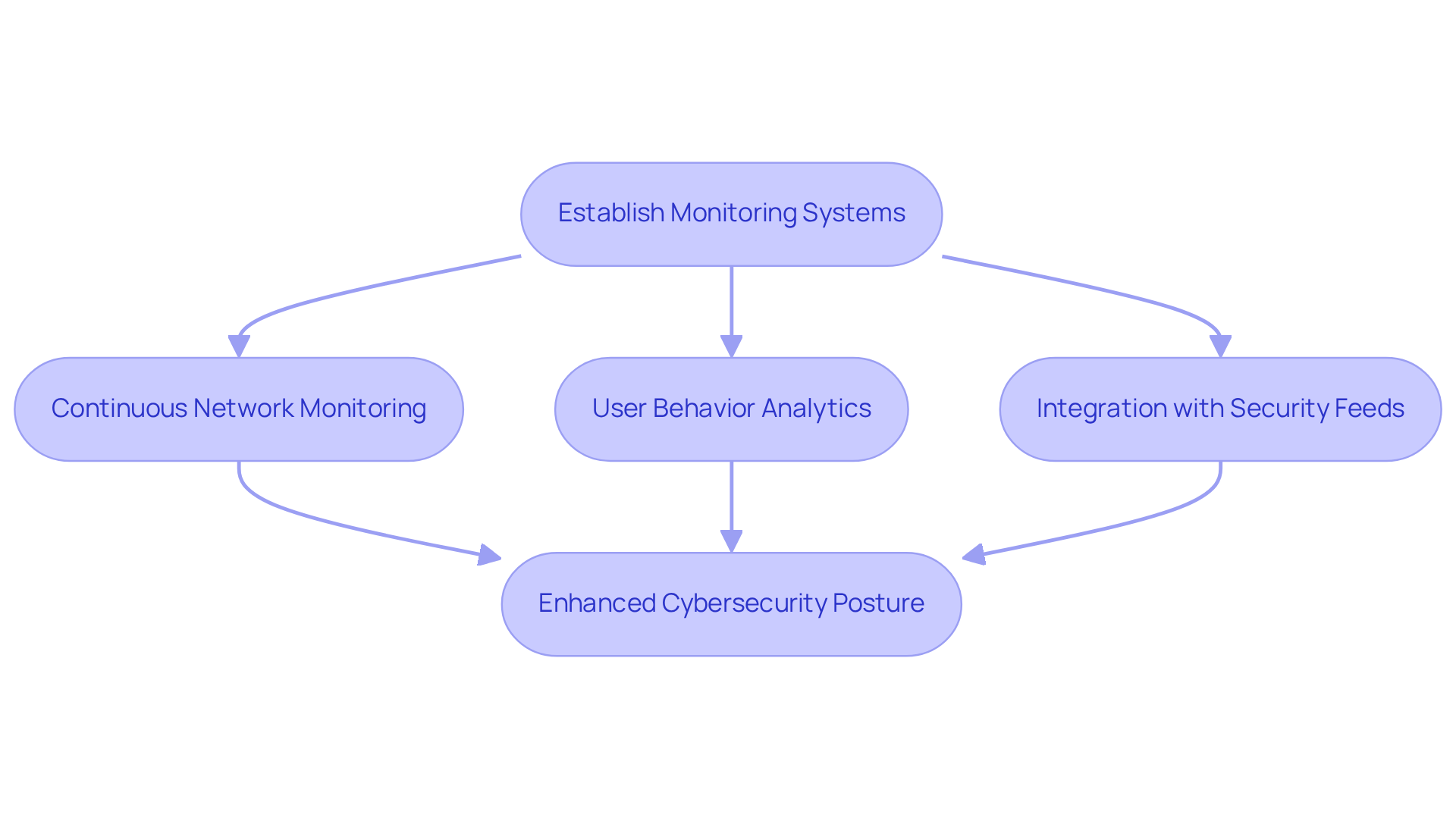
Adopt Compliance Frameworks and Standards
Implementing compliance frameworks and standards, such as the NIST Cybersecurity Framework or ISO/IEC 27001, is essential for businesses in the energy sector. These frameworks provide structured directives for risk management, incident response, and continuous improvement. By adopting these standards, organizations can not only meet regulatory requirements but also significantly enhance their overall cybersecurity posture.
Consider the complexities faced by energy companies today. With increasing regulatory pressures and evolving cyber threats, the need for robust cybersecurity practices has never been more critical. Compliance frameworks serve as a roadmap, guiding organizations through the intricacies of risk management and incident response.
The benefits of implementing these frameworks are substantial. They not only ensure compliance but also foster a culture of ongoing enhancement in cybersecurity practices. Organizations that prioritize these standards position themselves as leaders in the industry, capable of navigating the challenges of today's digital landscape.
In conclusion, the adoption of compliance frameworks is not just a regulatory obligation; it is a strategic imperative for energy sector businesses. Embrace these standards to strengthen your cybersecurity defenses and safeguard your organization’s future.
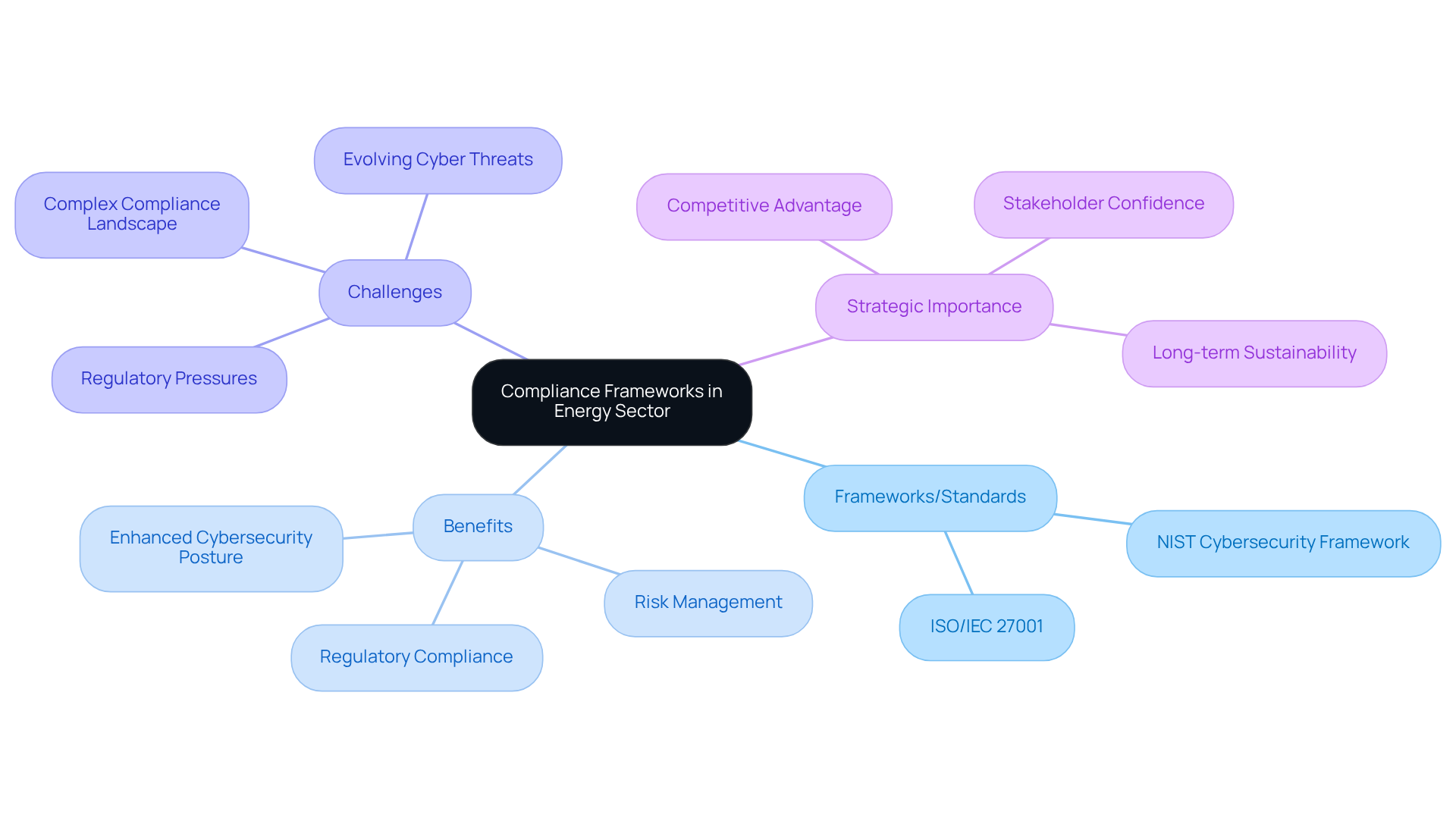
Implement Employee Training and Awareness Programs
Establishing staff training and awareness initiatives is crucial for fostering a security-aware culture within power firms. Regular training sessions must encompass critical topics such as:
- Phishing awareness
- Secure password practices
- Incident reporting procedures
By empowering employees with essential knowledge, organizations can significantly mitigate the risk of human error that may lead to security breaches. This proactive approach not only enhances individual competence but also fortifies the organization's overall security posture.
Leverage Advanced Technologies for Enhanced Cybersecurity
Advanced technologies, such as artificial intelligence and machine learning, present a transformative opportunity for energy firms to bolster their cybersecurity measures. These innovations facilitate the automation of danger detection, enabling the analysis of vast datasets for anomalies, and significantly enhancing incident response times. By integrating these sophisticated tools into their cybersecurity strategies, companies can proactively address evolving threats and protect their critical infrastructure with greater efficacy. The imperative is clear: adopting these technologies is not just beneficial; it is essential for safeguarding vital operations in an increasingly complex threat landscape.
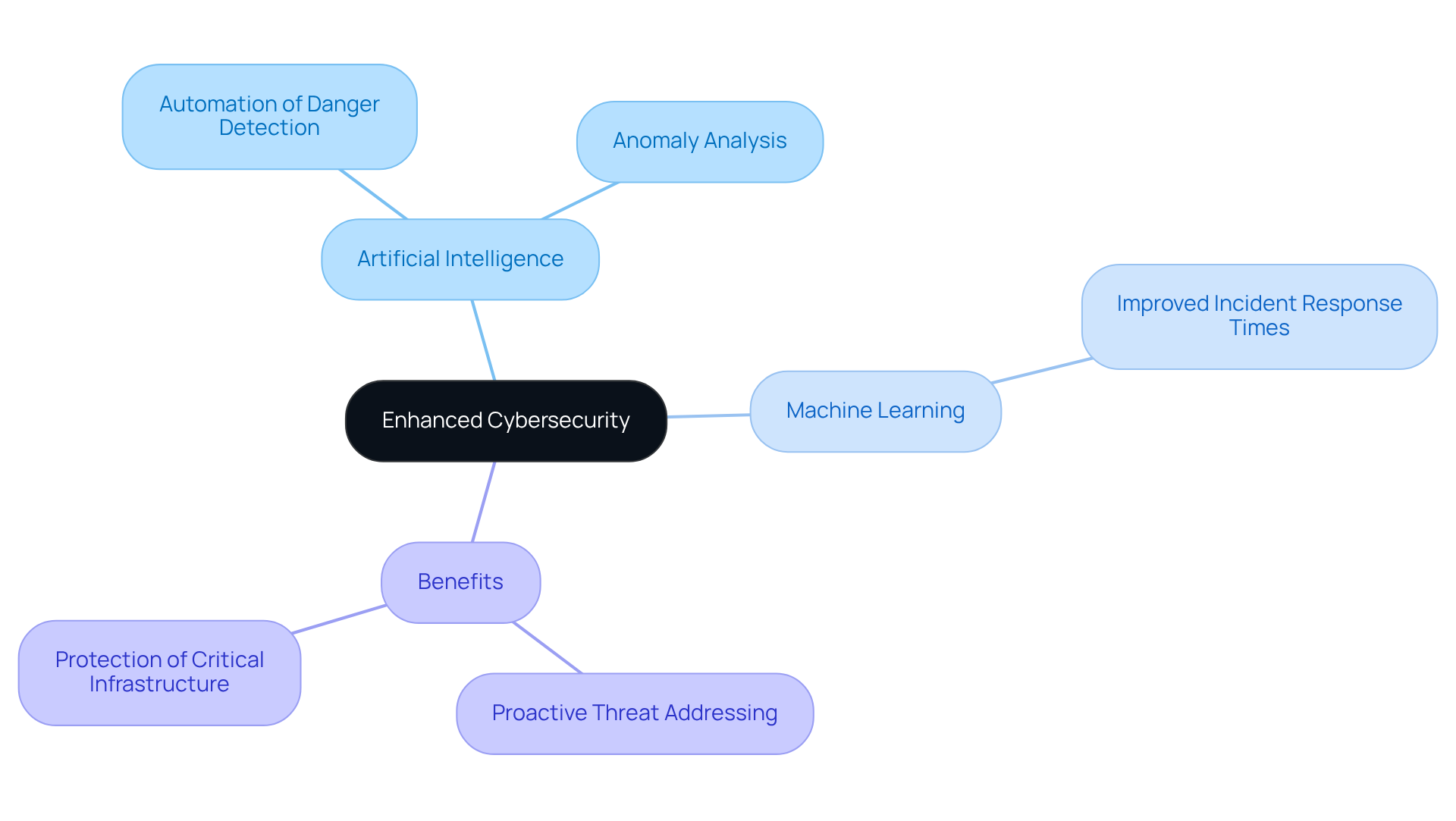
Conclusion
The integration of smart grid technology in the energy sector has not only led to remarkable advancements but has also revealed critical vulnerabilities that demand robust cybersecurity measures. Energy companies must implement the outlined strategies to protect their infrastructure from potential cyber threats and ensure operational integrity and resilience against evolving risks.
Key insights from the article underscore the necessity of:
- Vulnerability assessments
- Robust access controls
- The establishment of incident response plans
Regular evaluations and proactive measures are essential for identifying and mitigating risks. Moreover, employee training cultivates a culture of security awareness vital for effective cybersecurity. The adoption of advanced technologies, such as AI, can significantly enhance threat detection and response capabilities.
Given the escalating cyber threats confronting the energy sector, organizations must embrace these comprehensive cybersecurity plans. By prioritizing these strategies, energy companies can safeguard their operations, maintain compliance with regulatory standards, and ultimately contribute to a secure and resilient energy future. Taking action now is not merely a recommendation; it is a necessity for thriving in an increasingly complex digital landscape.
Frequently Asked Questions
What is Harbinger Land and what challenge does it address?
Harbinger Land is a solution that addresses the challenge of ensuring compliance with complex legal and regulatory requirements in the land acquisition process.
How does Harbinger Land optimize the title research process?
It leverages AI-powered title research software and document imaging solutions, digitizing property data and deploying imaging agents to courthouses or acquiring documents through records requests to enhance efficiency and cost-effectiveness.
What are the benefits of using Harbinger Land's technology for land acquisitions?
The technology accelerates acquisitions, minimizes the risk of conflicts and fraud, secures clear and reliable land titles, and allows firms to focus on their core operations without potential legal challenges.
How does GIS technology impact land acquisition?
Advancements in GIS technology streamline site selection and ensure compliance with zoning regulations, revolutionizing the land acquisition process.
What is essential for energy firms regarding smart grid cybersecurity?
Energy firms must prioritize thorough evaluations of their smart grid infrastructure as outlined in their cybersecurity plans to uncover vulnerabilities.
What components should be assessed in smart grid cybersecurity plans?
A meticulous assessment of hardware, software, and communication protocols is necessary to identify potential weaknesses that cyber attackers could exploit.
Why are frequent vulnerability evaluations important?
They are essential for maintaining a proactive strategy against emerging risks and ensuring that security measures remain current and effective.
What role do Chief Information Security Officers (CISOs) and General Counsels (GCs) play in addressing vulnerabilities?
Their collaboration is crucial for effectively addressing vulnerabilities, ensuring that evaluations are thorough and aligned with the strategic objectives of utility firms.
What are robust access controls and why are they important?
Robust access controls, including multi-factor authentication (MFA) and role-based access controls (RBAC), are vital for safeguarding smart grid systems by ensuring that only authorized personnel can access sensitive data and systems.
How does multi-factor authentication enhance security?
MFA requires multiple forms of verification beyond a username and password, significantly mitigating the risk of unauthorized access.
What best practices should organizations follow for access controls in smart grid systems?
Best practices include regularly reviewing user permissions, adhering to the principle of least privilege, and conducting thorough audits to identify and rectify potential vulnerabilities.
What risks should organizations be aware of regarding access controls?
Organizations must remain vigilant about the risks associated with physical tokens and soft tokens, as these can pose threats if not managed correctly.
List of Sources
- Harbinger Land: Advanced Title Research Solutions for Secure Land Acquisition
- 10 Benefits of Underground High-Voltage Systems for Energy Projects (https://blog.harbingerland.com/10-benefits-of-underground-high-voltage-systems-for-energy-projects)
- 2025 commercial real estate outlook (https://www2.deloitte.com/us/en/insights/industry/financial-services/commercial-real-estate-outlook.html)
- Keys for Successful Land Acquisition for Energy Projects | Vanguard Real Estate Solutions (https://vresolutions.com/blog/successful-land-acquisition-for-energy-projects)
- 100+ AI Statistics Shaping Business in 2025 - Vena (https://venasolutions.com/blog/ai-statistics)
- AI Statistics 2024 · AIPRM (https://aiprm.com/ai-statistics)
- Identify Vulnerabilities in Smart Grid Infrastructure
- The top 20 expert quotes from the Cyber Risk Virtual Summit (https://diligent.com/resources/blog/top-20-quotes-cyber-risk-virtual-summit)
- Implement Robust Access Controls and Authentication
- Energy giant upscales system security with multifactor authentication and passwordless access | Microsoft Customer Stories (https://microsoft.com/en/customers/story/1542040372928742487-dtek-energy-microsoft-365-en-ukraine)
- What Is Multi-Factor Authentication (MFA)? (https://cisco.com/site/us/en/learn/topics/security/what-is-multi-factor-authentication-mfa.html)
- Securing the Clean Energy Cyber Supply Chain: U.S. DOE's New Framework (https://secureworld.io/industry-news/doe-framework-energy-sector-security)
- What is: Multifactor Authentication - Microsoft Support (https://support.microsoft.com/en-us/topic/what-is-multifactor-authentication-e5e39437-121c-be60-d123-eda06bddf661)
- Conduct Regular Vulnerability Assessments and Penetration Testing
- 2024 Cybersecurity Statistics: The Ultimate List Of Stats, Data & Trends | PurpleSec (https://purplesec.us/resources/cybersecurity-statistics)
- Benefits of Penetration Testing as a Service (https://pentestpeople.com/blog-posts/benefits-of-penetration-testing-as-a-service)
- Vulnerability Assessment and Penetration Testing (https://qualysec.com/vulnerability-assessment-and-penetration-testing)
- 25+ Best Cybersecurity Quotes (https://atera.com/blog/best-cybersecurity-quotes)
- 83 Penetration Testing Statistics: Key Facts and Figures (https://getastra.com/blog/security-audit/penetration-testing-statistics)
- Develop an Incident Response Plan for Cyber Attacks
- Incident Response Statistics: How Do You Compare? | FRSecure (https://frsecure.com/blog/incident-response-statistics-how-do-you-compare)
- Energy Under Siege: How the Industry is Fighting Against Cyber Attacks (https://tripwire.com/state-of-security/energy-under-siege-how-industry-fighting-against-cyber-attacks)
- 29 Cybersecurity Quotes That Will Help You Take IT Security Seriously (https://acecloudhosting.com/blog/cybersecurity-quotes)
- Ensure Security of IoT Devices and Sensors
- Renewable Energy & Consumer IoT Security - A Critical Future (https://netgear.com/hub/network/security/renewable-energy-iot-security)
- Resecurity warns of increased cyber threats to energy and nuclear facilities from hacktivists and nation-states - Industrial Cyber (https://industrialcyber.co/utilities-energy-power-water-waste/resecurity-warns-of-increased-cyber-threats-to-energy-and-nuclear-facilities-from-hacktivists-and-nation-states#:~:text=However%2C%20increasing%20IT%2DOT%20convergence,sector%20introduces%20new%20security%20risks.)
- IoT Security Risks: Stats and Trends to Know in 2025 (https://jumpcloud.com/blog/iot-security-risks-stats-and-trends-to-know-in-2025)
- 19 Astonishing Quotes About The Internet Of Things Everyone Should Read (https://forbes.com/sites/bernardmarr/2018/09/12/19-astonishing-quotes-about-the-internet-of-things-everyone-should-read)
- Establish Monitoring and Threat Intelligence Systems
- 200 Inspirational Cybersecurity Quotes [2025] (https://digitaldefynd.com/IQ/inspirational-cybersecurity-quotes)
- 2024 Cybersecurity Statistics: The Ultimate List Of Stats, Data & Trends | PurpleSec (https://purplesec.us/resources/cybersecurity-statistics)
- cyburanus.com (https://cyburanus.com/blog/51-powerful-cybersecurity-quotes)
- Assistance Getting Through Your Cyber Security Audit for Energy & Utilities | Cirrus Technology Services (https://cirrusts.com/assistance-getting-through-your-cyber-security-audit-energy-utilities)
- 29 Cybersecurity Quotes That Will Help You Take IT Security Seriously (https://acecloudhosting.com/blog/cybersecurity-quotes)
- Adopt Compliance Frameworks and Standards
- NIST Releases Version 1.1 of its Popular Cybersecurity Framework (https://nist.gov/news-events/news/2018/04/nist-releases-version-11-its-popular-cybersecurity-framework)
- The Impact Of Cybersecurity On The Energy Sector, Embracing A Secure-by-Design Approach (https://cyberlegion.io/the-impact-of-cybersecurity-on-the-energy-sector-embracing-a-secure-by-design-approach)
- Advancing cybersecurity posture through a comprehensive maturity program in the oil industry - CEE Multi-Country News Center (https://news.microsoft.com/en-cee/2025/03/13/advancing-cybersecurity-posture-through-a-comprehensive-maturity-program-in-the-oil-industry)
- Key Compliance Statistics & Insights For 2025 | Zluri (https://zluri.com/blog/key-compliance-statistics-and-insights-for-2024)
- Implement Employee Training and Awareness Programs
- Train Employees And Cut Cyber Risks Up To 70 Percent (https://blog.knowbe4.com/train-employees-and-cut-cyber-risks-up-to-70-percent)
- Security Awareness Training Statistics and Trends (https://securitymentor.com/security-awareness-training-statistics-and-trends)
- Can Strong Security Awareness Reduce Cyber Risks? (https://linkedin.com/pulse/can-strong-security-awareness-reduce-cyber-risks-keepnetlabs-4pdif)
- The Impact of Security Awareness Training: Key Statistics | IMS Solutions Group (https://imssolutionsgroup.com/resources/blog/the-impact-of-security-awareness-training-key-statistics)
- Leverage Advanced Technologies for Enhanced Cybersecurity
- 2024 Cybersecurity Statistics: The Ultimate List Of Stats, Data & Trends | PurpleSec (https://purplesec.us/resources/cybersecurity-statistics)
- Solutions Review: Cybersecurity Awareness Month Quotes from Industry Experts in 2024 - Mark43 (https://mark43.com/press/solutions-review-cybersecurity-awareness-month-quotes-from-industry-experts-in-2024)
- Top 40 AI Cybersecurity Statistics | Cobalt (https://cobalt.io/blog/top-40-ai-cybersecurity-statistics)
- Top 10 Expert Quotes That Redefine the Future of AI Technology (https://nisum.com/nisum-knows/top-10-thought-provoking-quotes-from-experts-that-redefine-the-future-of-ai-technology)
- The top 20 expert quotes from the Cyber Risk Virtual Summit (https://diligent.com/resources/blog/top-20-quotes-cyber-risk-virtual-summit)




